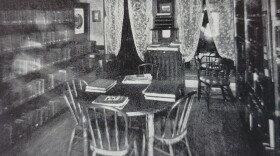Wildland fires are not uncommon in the Northwoods. On any given day DNR forestry personnel are dispatched to investigate and fight fires in the vast swathes of timber that cover much of our area.
One day in 1986, dubbed Black Tuesday, went down in History as the most wildland fires fought in a single day in Northern Wisconsin. By the end of that Tuesday, 64 fires would burn hundreds of acres.
Springtime in Northern Wisconsin is fire season. The irony is that as the snow melts, the lakes, rivers, streams, and wetlands are all full of water, but winter leaves the landscape full of dry debris such as dead grass, tree branches and pine needles, which make for a proverbial tinderbox before things green up.
The days before May 6th, 1986 had seen several days of very dry weather. No precipitation, low moisture, and increasing wind speeds make for a dangerous combination during fire season.
Black Tuesday started out like any typical spring day at the DNRs Woodruff Headquarters located off of Hwy J. Area fire tower staff made the 100-foot ascent to their perches above the trees, and firefighting crews staged around the Northwoods for another day of protecting our great forests. But many staff had an ominous feeling given the dry conditions and winds.
Increasing wind speeds throughout the morning saw gusts of 30 to 40 miles per hour, with some approaching 60. These high winds caused a series of fires to start created by sparks from downed power lines. The first fire of the day was reported at 10:37am in the vicinity of Laura Lake, northeast of Woodruff. After the first report from Laura Lake, fires continued to start all over the Woodruff Area covering Oneida, Vilas, and Forest Counties, as crews were sent out to fight them.

To make matters worse, Woodruff Headquarters had been dealing with phone outages, and no electricity, due to the high winds. As lines were restored, the day continued on with 17 fires started by Noon. It became apparent that more help would be needed.
Woodruff Headquarters became flooded with mutual aid vehicles and personnel staging to be dispatched to the fires. Radio and phone communications quickly became overwhelming making it difficult for all the radio traffic to get through. To put it in a word, it was chaos. Woodruff dispatch lead Dave Christensen had his work cut out for him, as he received radio communications, organized assets, and coolly dispatched orders to the growing number of crews. Fire Boss on duty that day Ken Sloan spent the day staying on top of the ever-increasing number of fires.
Many of the fires were deep in the forests, making them hard to locate from the ground. Assistance from fire towers and airplanes helped crews find the fires, as they worked to make a plan, and get them under control. The fires spanned from small, to large, some engulfing the trees and spreading rapidly. Heavy equipment was sent in to plow fire breaks, as crews with backpack water canisters went in on foot to put out the spreading flames.
Fires continued sparking off all day. News agencies from TV, Radio, and Print were arriving at Headquarters and out in the field to cover the unprecedented number of wildland fires. Public relations officer Dave Daniels was kept very busy. The phones at the station never stopped ringing. Many were media calls, but also the usual day to day calls from folks wanting to know about camping reservations, which lake was best for fishing, and what’s the weather going to be like next week, were also fielded. Many people from out of the area were not aware of the hectic day the Northwoods was enduring.
All day long, fires were quelled, crews returned to the station only to be dispatched again, or sent directly to new fires. The last fire of the day reported to the DNR was at 6:18pm. Fires were fought, and mopped up into the night by the hard working but exhausted crews.
When the clock struck midnight at the end of the day, 64 fires had been reported and controlled. 42 in Vilas County, 19 in Oneida, 2 in Forest, and 1 included in Lincoln County. Over 500 people would help to fight the fires including DNR staff, 25 volunteer and community fire departments, private citizens, and inmates from the local prison. 114 vehicles including DNR wildland firefighting trucks, fire department vehicles, bull dozers, tractors, and others were used. Approximately 332 acres of forest had burned on Black Tuesday, including cabins, and other buildings, leaving scorched patches of earth across the Northwoods. Thankfully, few serious injuries were reported.
After action reports speak of the incredible work done by DNR staff and the hundreds of people that assisted in fighting the many fires. Teamwork by DNR staff was noted as excellent and Black Tuesday was considered a success story for previous training efforts amongst the various organizations fighting fires that day. Dave Christensen, of Woodruff dispatch was commended in almost every report filed for his handling of radio communications. It was an all hands on deck day for Northwoods fire prevention professionals, and they all performed their duties exceptionally well.
Source: May 6th, 1986 Black Tuesday After Action Report, and various news articles from May 7th-10th, 1986.









